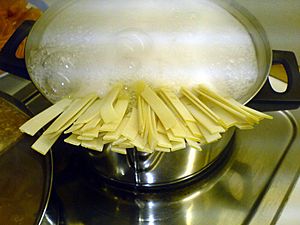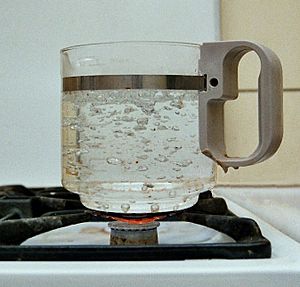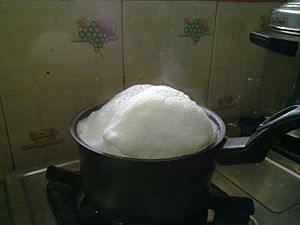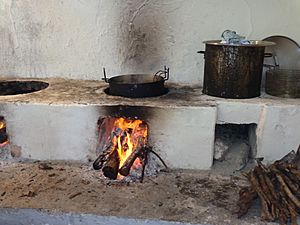Boiling facts for kids
Boiling is when a liquid, like water, gets hot enough to turn into a gas and form bubbles. These bubbles appear inside the liquid and then rise to the surface and pop. If bubbles don't form, and the liquid just slowly turns into a gas from its surface, that's called evaporation.
The temperature where a liquid starts boiling is called its boiling point. Different liquids have different boiling points. For example, water boils at about 100 °C (212 °F). When water boils, it changes into a gas called water vapor.
Contents
What is boiling used for?
Boiling is super useful! Here are some ways we use it:
- Cooking food: Many foods, like pasta or vegetables, are cooked by boiling them in water.
- Killing germs: Boiling liquids, especially water, can kill harmful germs and microbes that cause sickness.
- Cleaning objects: You can also kill germs on objects by putting them in boiling liquid.
Different ways liquids boil
Boiling isn't always the same! Scientists describe different ways liquids boil depending on how hot the surface heating them is.
Nucleate boiling
Nucleate boiling is the most common type you see, like when you boil water in a pot on the stove. It happens when the surface heating the liquid is just a little bit hotter than the liquid's boiling point. Tiny bubbles form at specific spots on the hot surface, like scratches or tiny bumps, and then float up. As the surface gets hotter, more and more of these bubble-forming spots appear.
If a surface is super smooth, like some plastics, the liquid might get hotter than its boiling point without forming bubbles. This is called superheating. It's like the liquid is "delaying" its boil.
Film boiling
Film boiling happens when the heating surface is much, much hotter than the liquid. When this happens, a thin layer of vapor (gas) forms all over the hot surface. This vapor layer acts like a blanket, insulating the surface and making it harder for heat to transfer to the liquid.
Boiling for clean water
Boiling water is one of the oldest and best ways to make it safe to drink. It kills most of the tiny microbes that cause stomach illnesses. It doesn't change the taste of the water and works even if the water has some dirt or particles in it.
While boiling is great for emergencies or when you're in the wilderness, it can't remove harmful chemicals or other impurities.
How fast germs are killed depends on the temperature. At 70°C (158°F), it might take ten minutes to kill some germs like Giardia. But at the boiling point (100°C or 212°F), most common illness-causing germs, like E. coli or Vibrio cholerae (which causes cholera), are killed in less than a minute. Some tough bacterial spores can survive boiling, but they usually aren't found in water or cause stomach problems.
The old advice to boil water for ten minutes is mostly for extra safety. Germs start dying at temperatures above 60°C (140°F), and seeing the water boil is an easy way to know it's hot enough without needing a thermometer. Even if you're high up in the mountains where water boils at a slightly lower temperature, it's still hot enough to disinfect the water.
Boiling in cooking

Boiling is a popular way to cook food using boiling water or other water-based liquids like broth or milk.
- Simmering is a gentler form of boiling, where the liquid is hot but only has tiny bubbles.
- Poaching is even gentler, where the liquid moves but barely bubbles at all.
The boiling point of water is usually thought of as 100°C (212°F). However, things like atmospheric pressure (how much air is pushing down) and what's mixed in the water can change this.
- High altitude: If you live in a place high above sea level, like Denver, Colorado, water boils at a lower temperature (around 95°C or 203°F). This means food might take longer to cook because the water isn't as hot.
- Pressure cookers: A pressure cooker works by trapping steam, which increases the pressure inside. This raises the boiling point of the water, making the food cook much faster at a higher temperature.
- Adding things to water: Adding things that dissolve in water, like salt or sugar, can slightly raise the boiling point. This is called boiling-point elevation. For example, when making thick sugar syrup, you'll notice it boils at a much higher temperature than plain water.
Many foods are great for boiling, including:
Boiling has some good points. It's usually safe and simple, and you can cook large amounts of food. It can also make tougher meats easier to eat. When cooking green vegetables, boiling them for a short time helps keep their color and nutrients.
However, there are also some downsides. When you boil foods, some vitamins can dissolve into the water. If you throw out the water, you lose those vitamins. Boiling can also be a slower way to cook some foods.
You can boil food in a few ways:
- Put the food into water that's already boiling rapidly, then turn down the heat to simmer.
- Put the food in a pot with cold water, then heat it until it boils and the food is cooked.
Boiling is also used to remove extra salt from foods like bacon if you want them less salty.
Boil-in-the-bag meals
"Boil-in-the-bag" meals are ready-made foods sealed in a thick plastic bag. You just put the bag, often frozen, into boiling water for a set amount of time. This is super convenient because you don't dirty any pots or pans! These meals are popular for camping and quick home dinners.
Boiling vs. evaporation
It's easy to mix up boiling and evaporation, but they are different!
- Evaporation happens at any temperature. Some fast-moving particles on the surface of a liquid can escape into the air as a gas. This only happens on the surface.
- Boiling happens when a liquid reaches its specific boiling point. Bubbles of gas form *throughout* the liquid, rise to the surface, and burst into the air. If you keep heating a boiling liquid, its temperature won't go up, but it will boil faster.
Related pages
See also
 In Spanish: Ebullición para niños
In Spanish: Ebullición para niños




